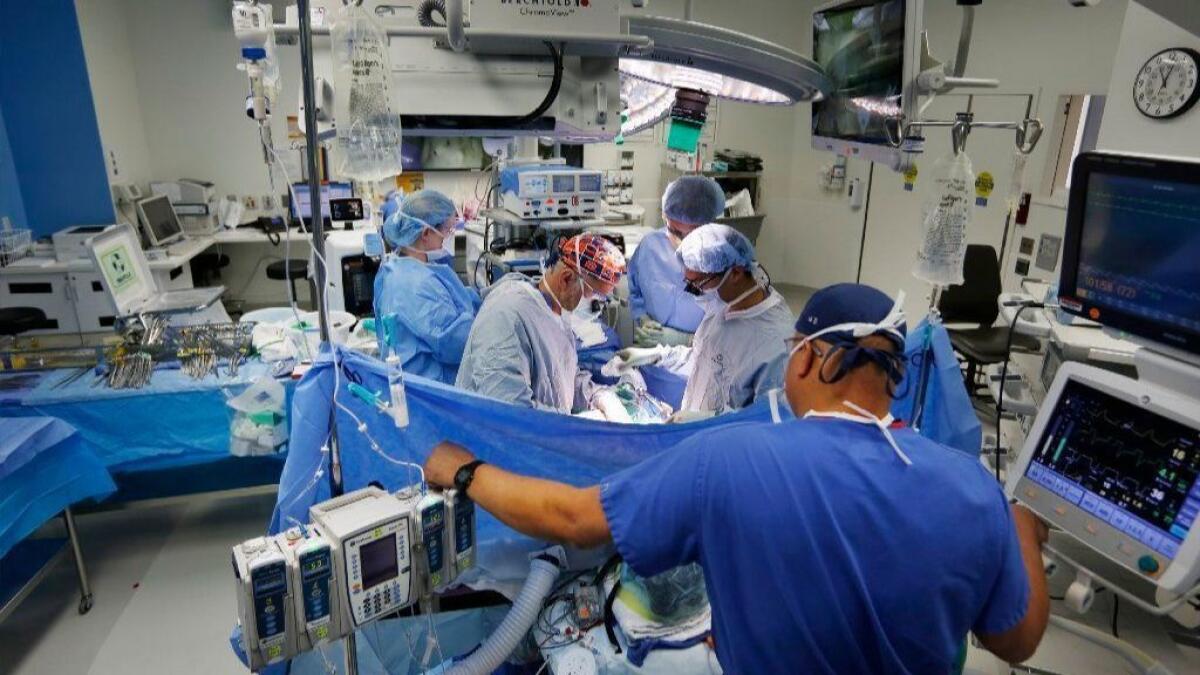Op-Ed: How we can save 500,000 lives in 2019 without even trying hard

- Share via
The latest mortality report from the Centers for Disease Control casts a wintry pall on American healthcare. For the third consecutive year, U.S. life expectancy fell. Our nation now ranks 29th globally in age-adjusted mortality despite leading the world in healthcare spending by a huge margin.
Dig beneath the drifts of data, however, and you’ll find reasons for optimism. Look at the 10 leading causes of death, for example. At least half of these could be dramatically reduced with the knowledge and technology physicians already possess.
Let’s start with the nation’s No. 1 cause of death, heart disease. With consistent monitoring of blood fat (lipids), and a low-dose combination of generic and over-the-counter medications, physicians in some practices have achieved a 40% to 50% reduction in mortality, according to a 2018 report in the American Journal of Medicine. Similarly, physicians have reduced stroke-related deaths (leading cause No. 5) by an equally high percentage thanks to close monitoring of blood pressure, along with inexpensive medications to control hypertension. Together, these clear-cut approaches could save more than 100,000 lives annually.
We can make inroads in preventing deaths from cancer, too, America’s No. 2 leading cause of death. Colon cancer kills more than 50,000 people each year and one-third of those deaths could be prevented with proper screening. For the overwhelming majority of people, screening doesn’t require a colonoscopy (or the uncomfortable bowel prep and risk of intestinal perforation that come with it). Instead, people as young as 45 can and should ask their doctors about FIT (fecal immunochemical testing). If you’re eligible, a doctor can mail a small test kit to your home, where the whole process will take you five minutes to complete with no pain or fuss.
Simple steps would go a long way toward reducing deaths from lung cancer, as well, which is the most frequent cancer-related killer. Cigarette smoking is linked to 80% to 90% of the estimated 155,000 lung cancer deaths each year. Strict local anti-smoking policies certainly help: We have those in California, and the death rate from lung cancer here is 28% below the U.S. average. But primary care physicians should also always ask about smoking and always offer cessation help. We did that when I led Kaiser Permanente, and lowered the rate of smoking among members to 50% of the national average.
If more Americans kept their New Year’s resolutions to improve their diet and exercise, we could greatly reduce the incidence of diabetes, our nation’s No. 7 cause of death. Meanwhile, the flu broke a U.S. death record last season, killing 80,000 people. Flu shots save lives most effectively when communities achieve a 70% vaccination rate, but fewer than half of Americans got one during the 2017-2018 flu season — a major reason influenza and pneumonia remain America’s No. 8 killer.
Medical errors aren’t even on the Top 10 list of causes because they rarely are highlighted on death certificates. But they account for more than 200,000 deaths annually. All errors can be avoided; otherwise they’d be accidents. We can start eliminating them by insisting all medical staff wash their hands between patient visits. Studies show that they don’t a third of the time, which can allow transmission of deadly infections from one person to the next.
These simple and proven measures, with little added cost to the healthcare system, could prevent at least half a million deaths in 2019.
Enter the Fray: First takes on the news of the minute from L.A. Times Opinion »
Of course, there are major barriers to more consistent care. Chief among them: People don’t have the time and hate going to the doctor. Still, I’m optimistic we can address this issue, too. That’s because at least a third of all visits to the doctor’s office could be replaced with video-based care, home monitoring and direct-messaging. Right now, only 15% of doctors offer these kinds of “virtual visits.”
Cost-effective technologies are everywhere, presenting all sorts of opportunities to improve medical care. Artificial intelligence (AI) is already 10% more accurate than the average physician when making diagnoses in the fields of radiology, pathology, ophthalmology and dermatology. And in many healthcare facilities, data analytics tell doctors which patients on general medical floors are likely to require ICU care tomorrow, and which individuals being sent home from the ER are likely to return the next day.
Put all the pieces together — evidence-based medical knowledge, available technology and successful healthcare practices — and 2019 could be the year we save a half-million lives. The new year presents countless opportunities to improve both our nation’s life expectancy and the care experience itself. And not one of these opportunities calls for a pricey new drug, a shiny new machine or a new killer app.
Dr. Robert Pearl was chief executive of the Permanente Medical Group (Kaiser Permanente) for 18 years. He’s the author of “Mistreated: Why We Think We’re Getting Good Healthcare — And Why We’re Usually Wrong” and hosts the podcast “Fixing Healthcare.”
Follow the Opinion section on Twitter @latimesopinionand Facebook
More to Read
A cure for the common opinion
Get thought-provoking perspectives with our weekly newsletter.
You may occasionally receive promotional content from the Los Angeles Times.










